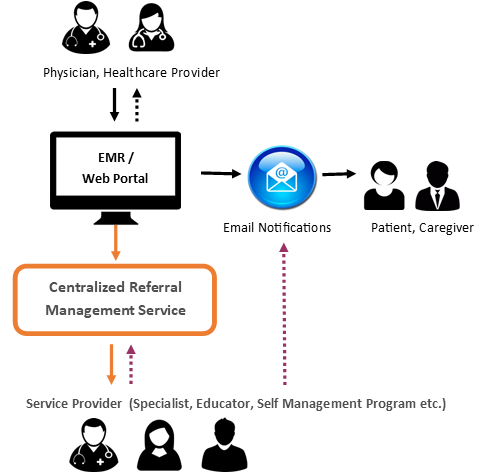eReferral and patient communication in care transitions
Patient-centred care (PCC) is a priority for the Ontario Ministry of Health (MOH).1 Communication between patients and providers is essential to sustain PCC.2 In September 2019, the College of Physicians and Surgeons (CPSO) identified new guidelines that make improved communication between referring physicians, consulting physicians, and patients a priority.3 When these requirements are met, patients will have timely access to care and become more informed throughout their care transitions.3
Communication that flows smoothly between referrers, specialists, and patients is a key measure to these requirements for patient-centred care. Traditional paper-based referrals make communication difficult.4 Difficulties are often due to physician’s time constraints, illegible referrals, and missing information.5 Studies show that electronic solutions have the ability to enhance the referral process through automated communications.2
eReferral enables automated email notifications that inform patients of their referral location updates, appointment dates, and preparation instructions.
So far, Ocean eReferrals has been implemented through the System Coordinated Access (SCA) Program in six regions across Ontario. To gain insight into the patient experience within the eReferral program, 13 patient interviews were completed in October 2019.
The patients were invited to participate through the patient experience survey, which is attached to the patient notification received for a booked appointment. The phone interviews used semi-structured questions to explore patients’ experience with the email notifications.
Key takeaways
Electronic Referral (eReferral) and email notifications enable communication between health care providers and patients through care transitions
Benefits
The interviews were completed with five male and eight female patients ranging in ages from 30 to 70 and above, all from within the Waterloo Wellington region. Overall, respondents appreciated the email notifications and acknowledged the benefits of communication during their transition of care. Patients seemed more informed of their care throughout the referral process.
Contrary to patients’ previous experiences with traditional referral methods, patients reported feeling more informed and engaged throughout their referral process.
So for me getting this notification, I was absolutely delighted. It made me feel good that I knew the process was moving forward. So much better than referrals that I have had before. I haven’t had a lot, but you talk to people… It might even be six or eight weeks before you even hear back that they have got your referral. So this is great.
And then my doctor followed up… you just feel more connected, you feel that you are cared for, that everybody wants to make sure this happens. It was really, probably the best feeling I’ve had in a long time.
Anonymous Patient
Patient Experience Survey
A key benefit identified was that patients were able to track their referrals with the email notification and were updated on the progress.
“It was really easy to see and follow…and there is a spot for comments, where they
explain the information because I needed to prepare for the appointment. So, it was nice to receive (the information) that way.”
Patients also felt that communication of information was clear and effective. Having documented information in a format that they could easily reference, when
needed, seemed valuable.
“I can actually keep it as a reminder. I can document it as a reminder for what’s coming up. I like the idea of that…I think that if you have it on an email then I can sit and read it… It’s not like someone phones you quickly and you have to answer all your questions right away. So, I like that idea that you could read it yourself.”

About the SCA Program
The System Coordinated Access (SCA) Program was originally initiated to support the development and adoption of electronic referral in the Waterloo Wellington region. As a result of an investment by the Ontario Government, the program, in collaboration with the Think Research Consortium (Think Research, CognisantMD and Centre for Effective Practice), has now expanded to support the implementation of eReferral to five additional LHINs.
eReferral replaces paper-based faxes with electronic referrals. Using integrated electronic medical records, referrals are sent, tracked and
updated right from the patient’s electronic chart. The local SCA deployment teams provide training, solution set-up and support.
Contact
If you have questions or would like more information on this Benefits Realization (BR) case study, please contact:
Kayla Wierts, Analyst, eCE
Communications@ehealthCE.ca
This document is not to be reprinted without permission from the eHealth Centre of Excellence.
1Ministry of Health and Long-Term Care. Patients First: Action Plan for Health Care, Patients First: Action Plan for Health Care (2015). Retrieved from http://www.health.gov.on.ca/en/ms/ecfa/healthy_change/docs/rep_patientsfirst.pdf
2O’Malley, A. S., & Reschovsky, J. D. (2011). Referral and consultation communication between primary care and specialist physicians: finding common ground. Archives of internal medicine, 171(1), 56-65.
3College of Physicians and Surgeons of Ontario. Council approves Continuity of Care policies. (2019, September 20). Retrieved from https://www.cpso.on.ca/News/Key-Updates/Key-Updates/Continuity-of-Care-policies
4Epstein, R. M., Fiscella, K., Lesser, C. S., & Stange, K. C. (2010). Why the nation needs a policy push on patient-centered health care. Health affairs, 29(8), 1489-1495.
5Gandhi, T. K., Sittig, D. F., Franklin, M., Sussman, A. J., Fairchild, D. G., & Bates, D. W. (2000). Communication breakdown in the outpatient referral process. Journal of general internal medicine, 15(9), 626-631.
Interested in learning more?
Interested in partnering with us or learning more about
what we can offer you? Please reach out here.
Get the latest resources and insights
-

Exploring the relationship between patient satisfaction and age with the eReferral process
Background The rapidly growing population of older adults is increasingly adopting technology, challenging the misconception…
-

eReferral supports mental health and addictions in Ontario
Key takeaways Electronic referral (eReferral) for Mental Health & Addictions (MH&A) has expanded across Ontario,…
-

eReferral Adoption Strategies throughout the COVID-19 Pandemic
Change Management Strategies during the Pandemic: Key takeaways Adapting change management tactics and clinical engagement…
-

Cybersecurity in healthcare: how Shield’s training program can help protect your organization
Cybercriminals are increasingly targeting healthcare institutions for their sensitive data, and the consequences of a…